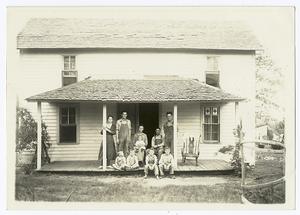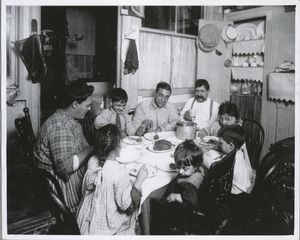Better Living Through Selective Breeding

Many months ago, I posted a piece about the valuable, but underused, collection of genealogical material in our division known as the Family Files. Among the myriad research notes, family newsletters, photographs, and miscellaneous material are a small number of files compiled by genealogists for submission to the Eugenics Records Office at Cold Spring Harbor on Long Island. It is in these files that, alongside notes on mother’s exceptional musical talent, we find accounts of the uncultivated, the “general no-counts” and various feeble-minded ancestors.
Eugenics, the theory that it is possible and desirable to improve future generations through selective breeding, gained its foothold in the United States at the laboratory at Cold Spring Harbor. The driving force behind the lab was Charles Davenport, one of the first and foremost proponents of the American eugenics movement. Davenport’s first studies dealt with physical traits like hair and eye color, yet his interests later shifted to the genetics of human traits that were not so easily quantifiable; for example, musical skill, sexual predilection and social behavior. This shift of focus was in part a response to similar studies going on in other countries.
The eugenics movement in the states had enormous consequences on our cultural, legal, and medical history. Scientists at the turn of the century were just beginning to figure out which traits could and could not be traced using Mendel’s laws of inheritance. In order to trace various characteristics eugenicists encouraged the study of both quantifiable and non-quantifiable physical, mental, and behavioral traits, along with medical conditions and the social habits of individuals and family groups. With the inherently questionable, and to our ears, the incomprehensible goal of “better breeding through selected pairing of individuals,” the belief in the scientific validity of eugenics led to the passage of odious anti-miscegenation laws and thousands of instances of forced sterilization.
As odd as the eugenics movement in America may seem to us today, it’s important to note that the belief in the social utility of eugenics was by no means limited to a fringe group of scientists. At the height of its influence eugenic-based studies and the conclusions drawn from them were endorsed by major figures such as Theodore Roosevelt and established scientific organizations like the American Medical Association and the National Academy of Science. Needless to say, the ideology of eugenics, especially after World War II, has largely been viewed at the territory of racists, nationalists and fascists. Yet for genealogists, as for historians, understanding this ideological mindset, this worldview of race and heredity, is imperative in understanding the material one studies during the research process. Such as it is, references, both direct and indirect, can be found in much of the literature and writings from the twentieth century. An early example of eugenically inspired thought can be found in Edward Bellamy’s utopian novel, Looking Backward, where kind, old Dr. Leete enthusiastically explains to his Victorian era visitor,
“…for the first time in human history the principle of sexual selection, with its tendency to preserve and transmit the better types of the race, and let the inferior types drop out, has unhindered operation. … Every generation is sifted through a little finer mesh than the last. The attributes that human nature admires are preserved; those that repel it are left behind."
A much more recent example can be found in Malcolm Gladwell’s article in the New Yorker, “The Courthouse Ring: Atticus Finch and the Limits of Southern liberalism” wherein Gladwell touches upon how the belief in eugenics, wherein poor white families could be labeled as ‘inferior stock’, influenced how Harper Lee constructed Atticus Finch’s defense in the trial in To Kill a Mockingbird.
For those interested in the history of the eugenics movement in the United States, the library, as always, has a wealth of material. The following list is just the tip of the iceberg:
Secondary material on the U.S. eugenics movement:
The Eugenics Movement: An Encyclopedia
Edited by Ruth Clifford Engs
Encyclopedias are always a great place to start research, and this volume has a number of fascinating entries (Better babies movement, with corresponding suggestions for further reading.
Evolution and Eugenics in American Literature and Culture, 1880-1940: Essays on Ideological Conflict and Complicity
Edited by Lois A. Cuddy and Claire M. Roche.
An interesting series of essays that traces the influence of eugenics movement on American literature and letters, from Absalom, Absalom! to Yonnondino.
Popular Eugenics: National Efficiency and American Mass Culture in the 1930s
Edited by Susan Currell and Christina Cogdell.
A collection of essays that look at how the eugenics movement influenced popular culture and rhetoric during the Depression.
White Trash: The Eugenic Family Studies, 1877-1919
Edited by Nicole Hahn Rafter.
This volume brings together and analyzes a number of the family studies of “degenerate clans” that had been influential for social workers, reformers, and policy makers of the Progressive Era. One of the earliest family studies, The Jukes; a study in crime, pauperism, disease, and heredity , can be accessed in its entirety online.
For the genealogists out there, the article “Files of the Eugenics Records Office: A Resource for Genealogists,” published in volume 82 (June 1994) of the National Genealogical Society Quarterly, provides an excellent overview of the wealth of genealogical material that was collected over the decades for use in eugenic family studies.
It would be remiss of me not to mention the online exhibit from the Cold Spring Harbor Laboratory, The Eugenics Archive an image based exhibit of material from the lab, covering all the major aspects of the American eugenics movement. A fascinating site.
Read E-Books with SimplyE
 With your library card, it's easier than ever to choose from more than 300,000 e-books on SimplyE, The New York Public Library's free e-reader app. Gain access to digital resources for all ages, including e-books, audiobooks, databases, and more.
With your library card, it's easier than ever to choose from more than 300,000 e-books on SimplyE, The New York Public Library's free e-reader app. Gain access to digital resources for all ages, including e-books, audiobooks, databases, and more.
If you don’t have an NYPL library card, New York State residents can apply for a digital card online or through SimplyE (available on the App Store or Google Play).
Need more help? Read our guide to using SimplyE.
Comments
It would be more honest if
Submitted by Atticus Finch (not verified) on August 21, 2009 - 3:13pm
Good point, Mr. Finch.
Submitted by Kate Cordes on August 22, 2009 - 11:48am
The discussion of eugenics
Submitted by Laura (not verified) on August 22, 2009 - 11:52am
For further reading I’d
Submitted by Billy Parrott on August 22, 2009 - 2:26pm